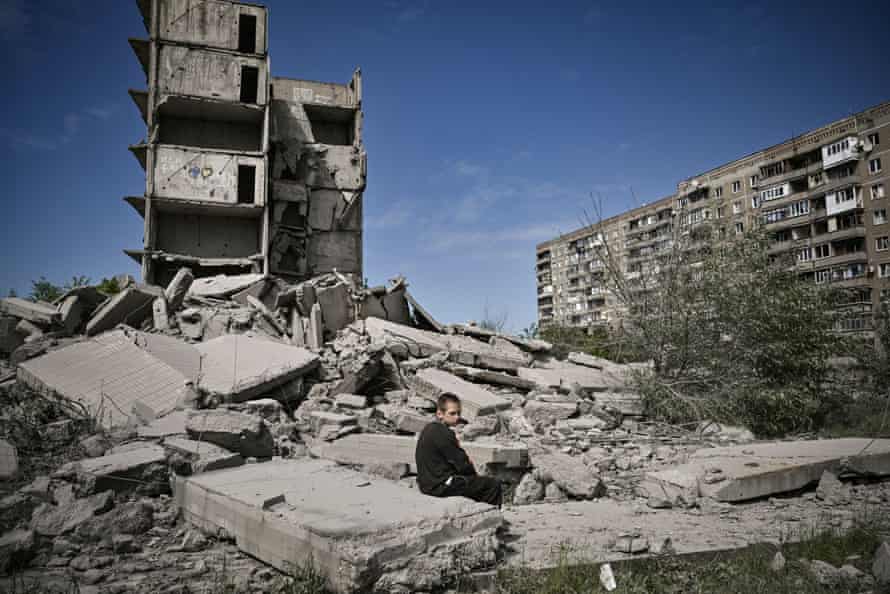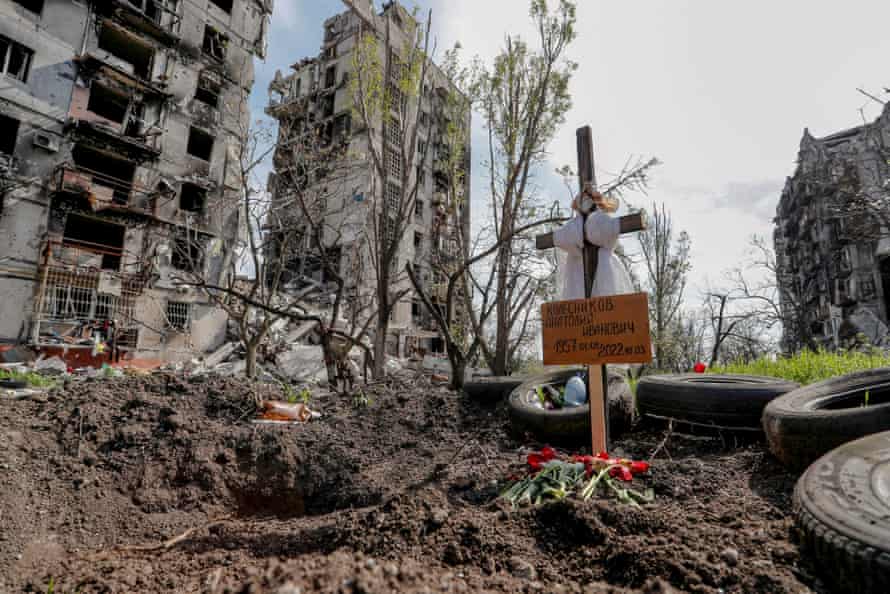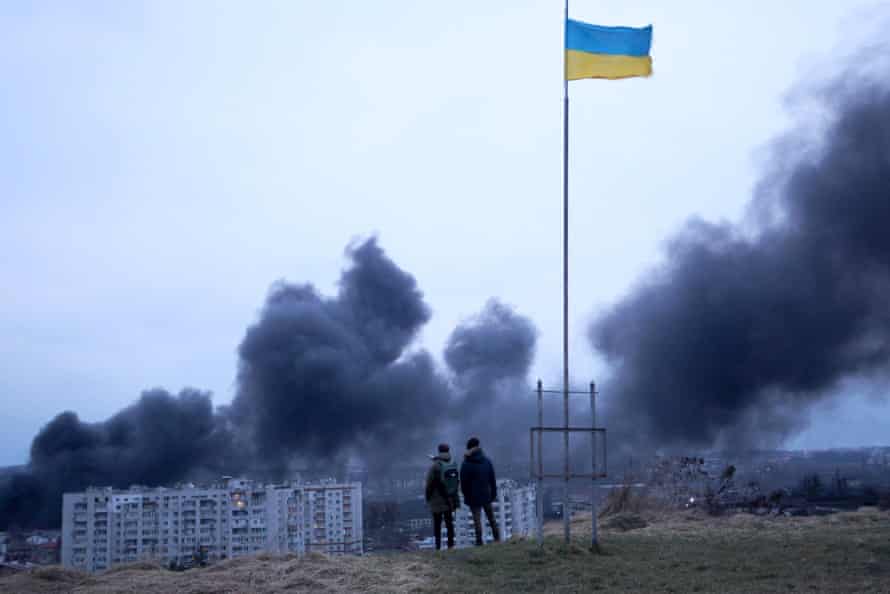Every week we wrap up the must-reads from our coverage of the Ukraine war, from news and features to analysis, visual guides and opinion.
100 days of a war that is reshaping Europe
Michael Safi and Courtney Yusuf charted the war, starting from the final hours of the decades-long peace enjoyed by Europe’s major powers.
On 23 February, Volodomyr Ksienich, a 22-year-old student organiser, spent the night with friends. They talked about the war, of course. “Nobody really believed it would happen,” he says.
Many analysts concurred. The Russian forces massing on the border were too few to occupy the country, they argued. State media had done little to prepare the Russian public for war. An invasion would trigger economic penalties so ruinous to the Russian economy that no leader would dare risk it.
All of this was true, and they were wrong.
Seán Clarke, Pablo Gutiérrez and Monika Cvorak tracked the bloody war of attrition that has since devastated Ukraine, killed thousands and displaced millions.
Their graphic guide charts the crisis in four phases: Russia’s initial invasion, the hampered advance into Kyiv, the retreat and reorientation of its forces, and the assault now under way in Ukraine’s east.
The progression of Russian control is recorded and superimposed across a map of Ukraine as the conflict progresses, as collated by the Institute for the Study of War and the American Enterprise Institute’s critical threats project.

The fight for Sievierodonetsk
Russia’s forces appear to be taking control of the strategically important city of Sievierodonetsk in Ukraine’s east, as more western allies promise additional missile systems and arms to Kyiv.
Jon Henley reported that 80% of the city is now in Russian hands. Capturing Sievierodonetsk would give the Russian president, Vladimir Putin, control of all of Luhansk – the region that, with Donetsk, makes up Ukraine’s Donbas industrial heartland – consolidating a shift in battlefield momentum after his forces were pushed back from Kyiv and northern Ukraine.
In scenes eerily similar to Mariupol and its Azovstal steelworks, about 800 people, including children, were reported to be hiding beneath a chemical factory in the city amid the fighting.
Peter Beaumont and the Guardian’s defence and security editor, Dan Sabbagh, reported on the high levels of attrition on the Ukrainian side, whose defenders have been pounded by Russian shelling. Ukrainian president Volodymyr Zelenskiy told the US Newsmax TV channel: “The situation is very difficult – we’re losing 60 to 100 soldiers per day as killed in action and something around 500 people as wounded in action.”
Gone for now are the Russian attempts at wider encirclements of Ukrainian forces in the Donbas, which included a failed river crossing in early May. Instead, units are focused on smaller encirclements – or “cauldrons” – and sheer concentration at Sievierodonetsk.
The expected loss of Sievierdonetsk, however, “is unlikely to be the crux” of Russia’s Donbas campaign, a western official said this week, adding that the war that could now grind on “to the end of the year” given the slow rate of Moscow’s advance.
The struggle to find and bury Mariupol’s dead
Isobel Koshiw reports on the tens of thousands of people trying to identify their loved ones in Mariupol after the besieged port city finally capitulated to Russian forces last month.
Petro Andryushchenko, an adviser to the city’s mayor, estimated that 22,000 died in the two months of fighting. However, one person among several coordinating burials in the city, who spoke on condition of anonymity, said they believed the total was closer to 50,000.
With the temperatures rising as summer approaches, the odour of dead bodies wafts down certain streets. There are bodies still trapped under rubble or in flats or buried in shallow makeshift or mass graves – a number of which appear to have been poorly marked or even unmarked. Others were left in the street and rotted, and some may have disintegrated if they were hit directly or burned in a fire.
Families navigate a chaotic burial process, spending days scrolling through social media groups and spreadsheets of those believed to have died, looking for news.

Biden answers plea for heavy weapons
Peter Beaumont reported on Joe Biden confirming he will send more advanced rocket systems to Kyiv, a critical weapon that Ukrainian leaders have been asking for as they struggle to stall Russian progress in the Donbas region.
As Luke Harding reported from Mykolaiv, such a deployment from the west has the potential to change the outcome of the war. Roman Kostenko, a member of Ukraine’s parliament and a special forces commander, told the Guardian: “If our partners give us heavy artillery and advanced systems like MRLS [multiple-launch rocket systems], we can win and take back occupied territory.”
However, world affairs editor Julian Borger noted that the deal was for just four systems and came with strings attached and was still weeks away from being operational. He wrote: “Biden has made clear that he will not allow a catastrophic failure of Ukrainian defences, but it is just as evident he has concerns about the implications of catastrophic success, a rout of Russian forces with the decisive help of western weapons, bringing with it the danger of a defeated Putin lashing out.”

Russia-linked superyachts ‘going dark’ to avoid sanctions threat
In the sparkling azure waters of Antigua, the gleaming £95m superyacht Alfa Nero could recently be seen at anchor by sightseers enjoying the Caribbean coastline. But few of the tourists who spotted its sleek black hull would have appreciated that it was quite a find, reported Jon Ungoed-Thomas and Gemma Handy.
Vessels with ties to Russian oligarchs hit by sanctions are no longer reporting their position to an automatic global locator, and the Alfa Nero – linked to the Russian billionaire Andrey Guryev – is one of them.
At least six superyachts linked to UK-sanctioned oligarchs have “gone dark” on ocean tracking systems as the global hunt for the assets of Russia’s super-rich intensifies, an investigation by the Observer revealed.
One crew member on a superyacht linked to a Russian oligarch sanctioned by the UK said: “We were told to turn off the AIS [automatic identification system]. We removed the screws on the power plug and pulled it out.”

No comments:
Post a Comment